Tuk Tuk Tours
Explore Bangkok by the iconic tuk tuk
Things to do, see and eat in Ayutthaya
Ayutthaya (officially called Phra Nakhon Si Ayutthaya) was the 2nd capital city of Thailand and one of the must visit places in Thailand. It not only plays an important role for Thais but was also made a UNESCO World Heritage Site in 1991. Located approximately 70 miles North of Bangkok, means it is a great option for a day trip from Bangkok.
There are so many things to explore including temples, palaces, markets and local food. In our guide to Ayutthaya we provide all you need to know to enjoy a visit to the city. Click and get access directly to any of these sections below:
Ayutthaya was the second capital city of Siam, the original name of the country before Thailand. The first capital city was Sukhothai, to the north of Ayutthaya. During the Sukhothai period, Ayutthaya existed and was believed to be founded in 1350 as a part of the Sukhothai Kingdom. The city at that time was important as a trading port with overseas countries. Around 1378, Ayutthaya became a thriving city while the Sukhothai Kingdom was fading, and Ayutthaya became the second and the longest-ruled capital city in Thai history.
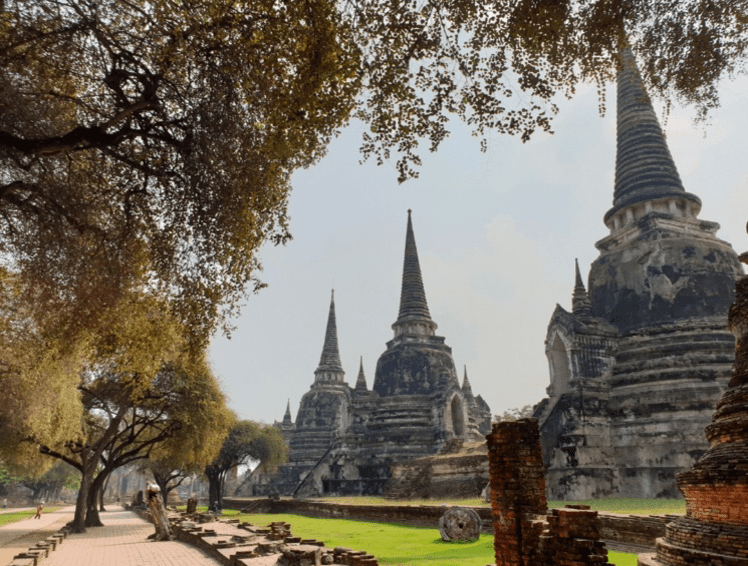
Ayutthaya was once a hub of trading for international merchants from all around the world, and also one of the world’s largest and most cosmopolitan urban areas. The city flourished with temples, large palaces and stunning waterways, and was surrounded by 3 rivers: the Chao Phraya River, the Pa Sak River, and the Lopburi River, that all served as natural barriers against invaders. Also, the inner city was intersected by many canals and houseboats. People used canals as the main transportation routes and Ayutthaya became well-known as the Venice of Asia.
Ayutthaya was the capital city for 417 years until it was destroyed by the Burmese army in 1767. The city was burned to the ground and the royal family and their inhabitants were forced to abandon and move to Burma. Three months after the city was demolished, General Taksin, who then ascended to the throne, was successfully able to dispel the Burmese army out of Ayutthaya and decided to move down to the south of the Chao Phraya River and settle the new capital city in Krung Thonburi, opposite modern-day Bangkok. The King decided not to rebuilt Ayutthaya because the city was severely damaged and unable to stand against the Burmese who knew the location well.
Today, Ayutthaya attracts many tourists to its World Heritage Site and it’s relatively easy to visit many beautiful places independently.
Ayutthaya is 80-kilometers from Bangkok by road, approximately a drive of 1.5 hours. This city is one of the best options for a one-day tour out of Bangkok. The Ayutthaya Historical Park with it’s temple ruins and several museums provide insight into the history.

Wat Phra Si Sanphet was the most important temple during the Ayutthaya period as it was part of the royal palace complex. This temple was the original home of the Emerald Buddha, now located in the Grand Palace, Bangkok.
This temple had been built over many centuries during many kings’ reigns. It began in the reign of King U Thong, the first king of Ayutthaya. Around 90 years later, the large pagodas which are the signature of this temple were constructed in the reign of King Ramathibodi II for the sake of enshrining the ashes of his father and older brother. The third large pagodas were constructed in three decades later to install the ashes of King Ramathibodi II as an order of King Narai The Great. Also, he ordered a large cross-shaped sermon hall, knowns as ‘viharn’ in Thai, to be built, named Prasat Phra Narai. Nowadays, the viharn no longer exists as it was destroyed during the war, standing only in its place are three massive pagodas without any gold covering, like it was when first built.
Additionally, Wat Phra Si Sanphet was the house of an enormous 16 meters gilded image of the standing Buddha named Phra Si Sanphet, which is one of the most beautiful and important Buddha images in Ayutthaya Kingdom. The image was covered by 340 kilos of gold and located in the Viharn Luang, the royal assembly hall in the palace. During the war, the covering gold was melted down and taken to Burma. The remaining bronze core was taken to Bangkok where it was restored and enshrined in a pagoda of Wat Pho.
Opening hours: 08.00-18.30
Entrance fee: 50 THB

During Ayutthaya period, Wat Mahathat, also known as ‘the temple of the great relic’ was one of the most important temples located close to the palace. This temple enshrined Buddha relics and was the residence of the Supreme Patriarch, leader of Thai Buddhist monks during that time.
This temple was built following the concept of Khmer architecture: a complex of prangs (tall tower-like structures), assembly halls and ordination halls were built following the Hindu and Buddhist views of the universe during the reign of King Boromma Rachathirat I, the beginning of Ayutthaya period. The great prang was built as the core of this temple to enshrine the Buddha relic. Before the last war of Ayutthaya, the central prang accidentally collapsed but then was re-built by the people at that time.
During the last war, this temple was set on fire, so all buildings were burnt, and the prang also collapsed once again. Sadly, no one re-built the temple until now.
Nowadays, Wat Mahathat is a popular tourist attraction. Its signature is the tree root with a Buddha head embedded in it. No one knows exactly how it was made. One idea is that a thief cut off the head of a Buddha image and hid it in the tree without returning. As time passed, the tree grew and covered the head with its root.
Opening hours: 08.00-18.30
Entrance fee: 50 THB

Wat Ratchaburana was built during the early Ayutthaya period in the reign of King Sam Phraya. The king ordered this temple to be built in remembrance to his 2 older brothers who fought each other to be the next king after the late king’s father passed away. Both died in the battlefield, so the throne eventually became the right of the youngest brother, Chao Sam Phraya. Therefore, he ordered to build the temple in the location where his brothers were cremated.
The main shrine (ubosot) is at the entrance of this temple. The remaining wall and ruined pillar are still standing. The roof has been lost for a long time but it offers an interesting view of the prang located in the center. The central prang was built in Khmer style. Inside the prang there was a hidden crypt that no one knew about. Up until 1957, the crypt was looted. Many thieves dug beneath the prang and found a treasure room with many valuable Buddha images, tablets made of solid gold, golden royal regalia along with incredible murals covering the walls.
A year after the crypt was discovered, the Fine Arts Department took control and restored the temple. Some treasures left inside were moved to Chao Sam Phraya National Museum. Some stolen treasures were returned as some of the thieves reported terrible supernatural experiences from the curse and ghosts.
Opening hours: 08.00-18.30
Entrance fee: 50 THB
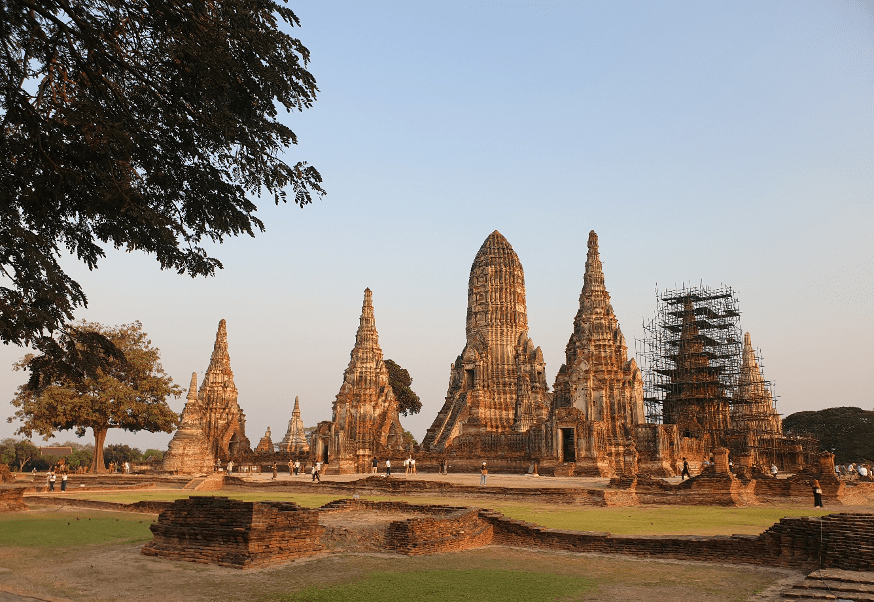
Wat Chaiwatthanaram was the royal temple located by the river bank outside the historical island. In 1630, King Prasat Thong ordered this temple be built in remembrance of his mother and as a symbol of his victory in the war between Ayutthaya and the Khmer. Therefore, this temple was built with Khmer architecture following the concept of the Khmer mountain temples of Angkor to symbolize the universe in Buddhist and Hindu cosmology.
The main prang is believed to contain relics of the Lord Buddha and many small prangs surrounding contain the ashes of the royal family. One of the prang stores the ashes of Crown Prince Chao Fah Goong. He was well-known for his poetic skills. He was accused of having an affair with his father’s consort, so the crown prince and the consort were sentenced to death. They were buried at this temple. Many people said that they saw the couple dressing in full Thai-style dress and walking inside this temple during the full moon day.
During the war with Burma, this temple was used as the Burmese army camp. After Ayutthaya Kingdom fell, the temple was burnt and looted. People abandoned the temple and selling its remaining bricks became common practice. Conservation of the compound was started finally in 1987 by the Thai Fine Arts Department. Nowadays, Wat Chaiwatthanaram is considered as the most impressive temple in Ayutthaya.
Opening hours: 08.00-18.30
Entrance fee: 50 THB
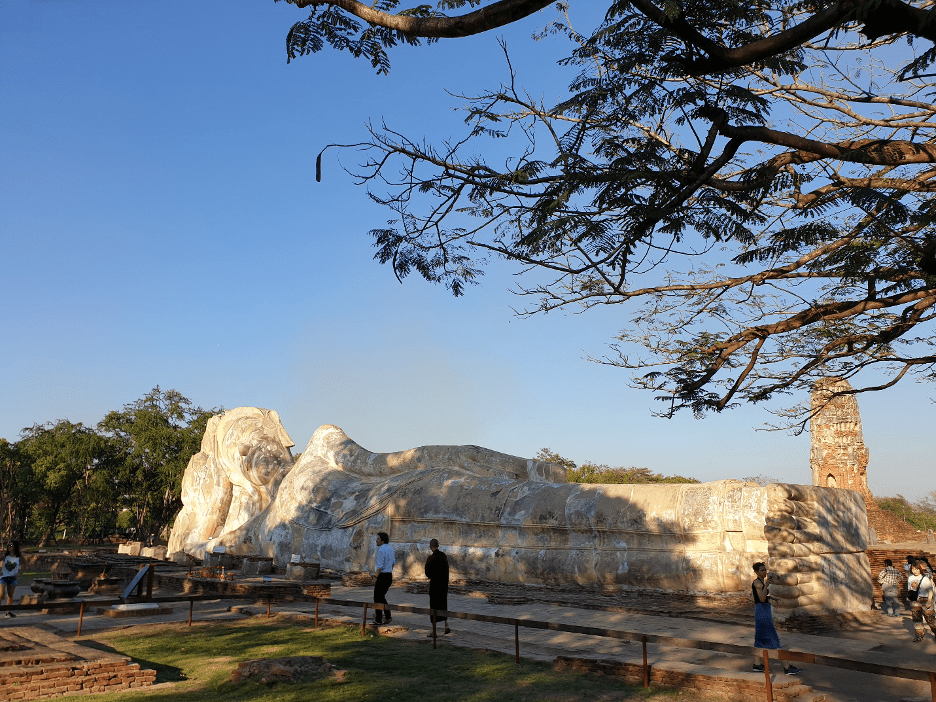
The signature of this temple is the biggest reclining Buddha image in Ayutthaya historical island, 42 meters long and 8 meters high usually draped in orange cloth. The temple was estimated to be built in the middle age of the Ayutthaya period. Little is known about the exact story of the temple but it was located near the ancient palace, so it was likely an important temple.
Opening hours: 08.00-18.30
Entrance fee: Free
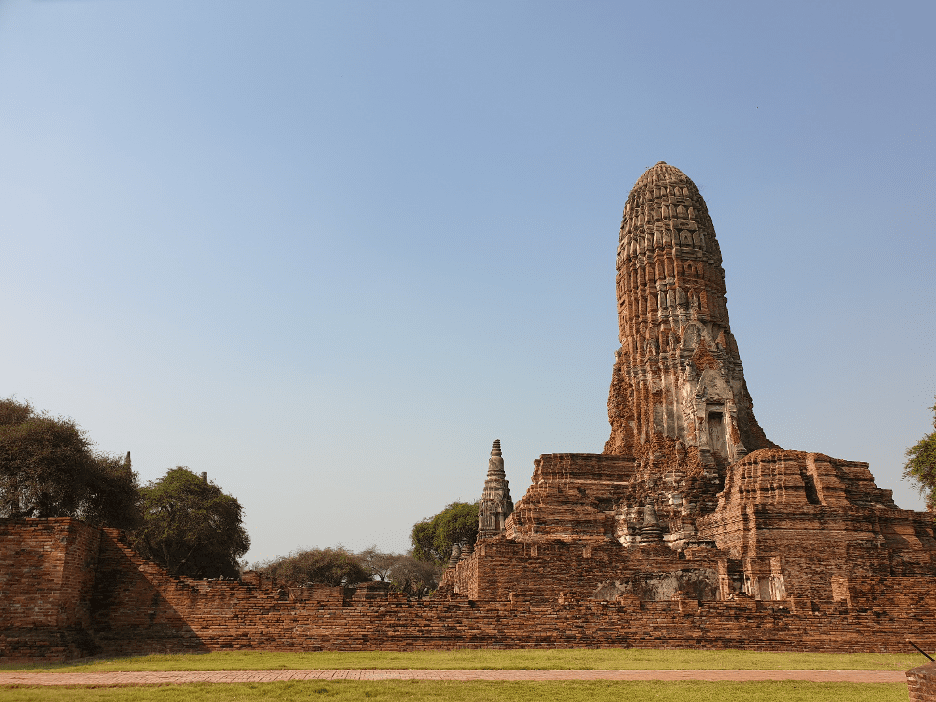
The temple was built in the early Ayutthaya period. The location of the temple represents the cremating area of King U-Thong, the first king of the Ayutthaya Kingdom. Wat Phra Ram is located in the center of Ayutthaya Historical Park, but is often skipped by tourists, as they are likely to visit more famous temples nearby such as Wat Mahathat and Wat Phra Si Sanphet.
This temple was also built in Khmer style. The great prang is still in good condition and is surrounded by pagodas and stupas both medium and small sizes. The temple is considerably more tranquil than any other of Ayutthaya’s popular temple ruins around the historical park.
Opening hours: 08.00-18.30
Entrance fee: 50 THB

Also called ‘Wat Laung Po To’, the temple presents a gigantic seated-style Buddha. The whole Buddha image splendidly glides in the posture of subduing Mara. From the beginning, the Buddha image was built without the hall around it. According to historical records, the original temple was built before the founding of Ayutthaya city. This was one of the oldest temples in Ayutthaya, but the original building is believed to no longer exist due to the long period of time passed and damage from the war. Nowadays, the temple is very lively and modernized. The massive hall was built to house the Buddha.
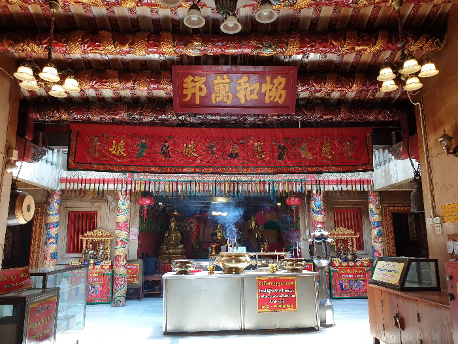
At the very first build of this temple, there was a story of a Chinese princess related to the temple. A long time before the Ayutthaya period, the King wanted to marry the daughter of a Chinese emperor. The princess named Soi Dok Mak was sent to Siam to marry him, but when she arrived at the city by the river, the king was not there to welcome her. After waiting for a long time, she decided to commit suicide by holding her breath. After she passed away, the king was in deep grief and decided to build the temple in the location where she was cremated.
Nowadays, by the river bank near this temple, there is located a small Chinese shrine. The first floor enshrines Guanyin or the Goddess of Mercy, and the second floor holds the statue of a Chinese lady representing Princess Soi Dok Mak.
The big Buddha seat image is also called ‘Som Bo Kong’ which means good luck in sailing. So, this temple is popular among Thai and Chinese tourists.
Opening hours: 08.00-17.00
Entrance fee: 20 THB

Wat Yai Chai Mongkhon is located in the east and far from the ruined temples in Ayutthaya Historical Park, around 10 mins drive. Many people rate this temple on the top of visiting lists when coming to Ayutthaya. The temple is still active and monks reside onsite.
The highlight is a massive stupa which can be climbed to see views of the whole monastery.
The temple was founded at the beginning of the Ayutthaya Kingdom by an order of King U Thong, the first king. At first construction, only small chedis and an assembly hall were built to be the house of the Supreme Patriarch of the forest sect of Buddhism, called Patriarch Vanarat. The temple’s original name was Wat Pa Keaw. The Supreme Patriarch from this temple played an important role as the King’s advisor for many states during the Ayutthaya period.
The massive stupa was built later in the reign of King Naresuan The Great to commemorate his victory against the Burmese army. At that time, the capital of Ayutthaya came under siege of Burma for the first time and it took 15 years to be free again. In 1592, the Burmese army led by the Crown Prince Commander with huge army troops, tried to subjugate Ayutthaya again. King Naresuan defended the invasion and fought back in one-to-one combat against the Crown Prince, both on elephants at the district of Nong Sarai in the province of Suphanburi. Both fought on elephants with no support from any soldiers.
There was a legend that King Naresuan’s elephant accidentally got in a rut and ran toward the frontline though the Burmese zone. No soldiers were able to stop him in time. He decided to challenge the Burmese Crown Prince to one-to-one combat fighting on elephants. Finally, King Naresuan won the war.
After he came back to the capital, the King wished to execute the soldiers who could not support him in the war, but Patriarch Vanarat begged the King to forgive them and advised him to build a pagoda in memory of his great victory. The pagoda was called in Thai ‘Chedi Chai Mongkhon’ and became known by its official name Wat Yai Chai Monkhon.
Opening hours: 08.00-18.00
Entrance fee: 20 THB

The temple is located on the riverbank opposite Ayutthaya Historical Park. By its location, travellers can combine this temple visit with Wat Chai Wattanaram which is on the same side of the river.
The temple was built in the early Ayutthaya Kingdom during the reign of King U Thong, the first king. The purpose was to commemorate his elder brother who defeated the Khmers and brought many Khmer people back to Ayutthaya. So the main prang was built in Khmer style.
During the glorious time of Ayutthaya, this temple was a Thai martial art school and many war lords in Ayutthaya learnt from here. Although during the last war most of the soldiers had been ordered to protect the city inside the wall only, no one had secured this temple. The Burmese then used it as their camp and attacked Ayutthaya.
Now Wat Putthai Sawan has become more famous among Thais after it was used as the location in a famous TV show. Thai people love to wear traditional costumes and take photos against the temple backdrop. Additionally, the temple is famous for lucky charms, votive tablets and amulets. You can find the Buddha subduing mara statue inside the ordination hall, which local people believe that we can ask Buddha to help us in many things such as recovery from illness, looking for love, and even the wish for a baby.
Opening hours: 08.00-17.00
Entrance fee: None
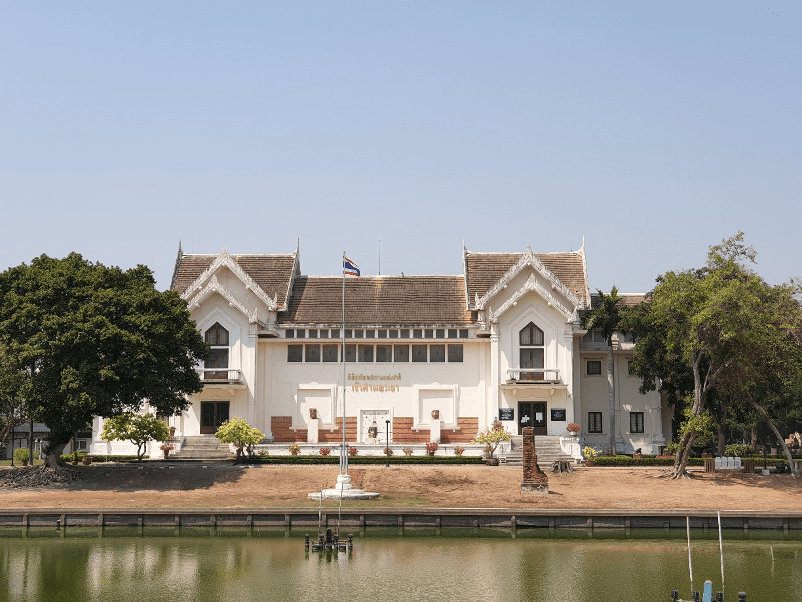
Chao Sam Phraya National Museum is the most important museum in Ayutthaya which was officially opened in 1961. The Chao Sam Phraya museum exhibited several thousand items including Buddha statues, votive tablets, gold artifacts and other treasures recovered from the crypts from many temples in Ayutthaya, especially valuable items from Wat Ratchaburana.
The museum collection is exhibited in three buildings. The highlight is in the main building where there is a large selection of treasure, gold artifacts, royal insignia, bracelets, headgear, necklaces, braces, rings, golden votive tablets, and a golden sword of the King that show great craftsmanship from Wat Ratchaburana and Wat Mahathat.
Gold treasure is exhibited in the air-conditioned room and presented in modern style. Each artifact is labelled in Thai and English. There is also another room dedicated to the Buddha relics discovered in the crypt of the Wat Mahathat.
Photography is not allowed in the exhibition room.
Regulations when travelling in Ayutthaya Historical Area

Things to be aware of
Opening hours: 09.00-16.00
Entrance fee: 150 THB ** Closed on Monday**
About 24 km away from Ayutthaya there is a palace named Bang Pa-In Royal Palace (also known as Bang Pa-In Summer Palace). Originally it was built in the 17th century by King Prasat Thong of Ayutthaya but later was restored in the 19th century by King Mongkut (King Rama 4).
By paying a fee of 100 THB per person, visitors can spend quality time looking at the different architectural styles of buildings inside the complex. The styles include classical Thai style, Chinese and some inspiration from European styles as well. The grassland is well-maintained and gives a perfect balance for this photogenic complex. It is open from 8:30AM till 4:00PM so you have enough time to look deep into architectural and historical aspects of this massive palace. By saying massive, we really mean it because there are not many palaces where you can rent a gold cart to look around. Yes, you can rent a gold cart at 450THB for the first hour and 100THB every additional hour.
Being a summer palace actually requires proper dress code as well. You are required to wear appropriate clothing to enter. For example, shorts are not allowed, you will be required to cover your knees and shoulders. Even denim with rough patterns or designs are not allowed. Don’t worry if you are not dressed appropriately because outside the palace you will find a dress hire service for cheap.
Opening hours: 08.30-16.00
Entrance fee: 100 THB
Sitting on the bank of the Chao Phraya River is this huge Arts and Craft center known as Bang Sai Museum. Built in 1984 and well-inaugurated by Her Majesty Queen Sirikit, this museum is a source for learning and establishing skills in Thai craftsmanship in order to promote supplementary skills and work opportunities for local people. This huge structure consists of several buildings dedicated to different crafts like weaving, ceramic making, Khon mask making and more.
There is also a bird park and fish aquarium so everyone can spend quality time there. The admission fee for foreigners is 100THB for adult and 50THB for children. Well-suited for kids, you can spend a good amount of time from 8:30AM till 5:00PM.
If you ask local people what the favourite food of Ayutthaya is, many of them will say boat noodles or ‘kuay teaw rue’.

Boat noodles will be served in a small quantity. To complete a meal, you can order 5-10 dishes. Boat noodle soup has the uniqueness differentiated from other soup because blood is added. So, it is not clear soup, but it is good with a thick and intense taste.
The name of the dish comes from how it is served. The noodle came to customers’ houses by boat. In the past, people used the canals for transportation. Every house faced the waterways. The noodle boat would stop at each house pier which was very convenient for customers and boat noodle have become a favourite for tourists to try.
Some say boat noodles originated from Ayutthaya but there is no official record of this. Nowadays, canals play a lesser role in transportation as many have been covered up and roads built over instead. So boat noodles no longer come by canal. But many are offered in certain places and still use a boat as decoration as the selling point.
In Ayutthaya, more than a hundred boat noodle shops are located in the city. But the most outstanding boat noodle restaurant is Aunti Lek Boat Noodle or ‘Kuay Teaw Rue Pa Lek’. Many people say this is the original boat noodle with the real taste of Ayutthaya.
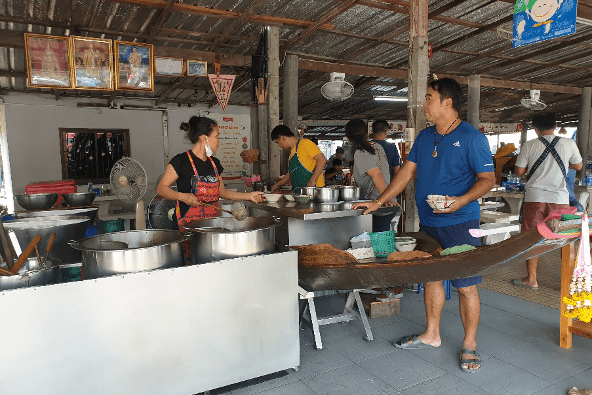
Location: Opposite to Wat Mahathat
Opening hours: 08.00-17.00 daily
Price: 15-20 THB/dish
Apart from food, there is also a famous snack which everyone visiting Ayutthaya will buy to take back home. You shouldn’t miss trying ‘roti sai mai’, Thai-style candy floss or cotton candy rolled in paper-thin roti sheets.

The street stalls offer this snack throughout the city. Roti sai mai is influenced by a Muslim recipe, as many Muslim communities have lived in Ayutthaya for a long time. The sweet was widely made and sold by Muslim vendors before spreading out to the public nowadays.
Ayutthaya is located along the Chao Phraya River in the north of Bangkok around 80 km away. There are many transportation options to get there.
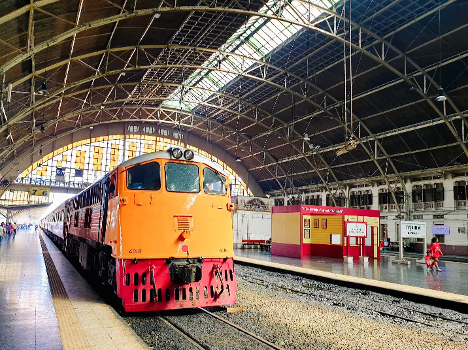
Many trains leave daily from Hua Lamphong to Ayutthaya. Online booking is also available at least 2 hours before departure time. You can search the direct website of the State Railway of Thailand:
https://www.thairailwayticket.com/eTSRT/default.aspx?language=1
This website offers reasonable prices from the government but it is a bit difficult to use the booking system. There also other private websites to book transportation, which is friendly to use, but the price likely includes a higher mark-up.
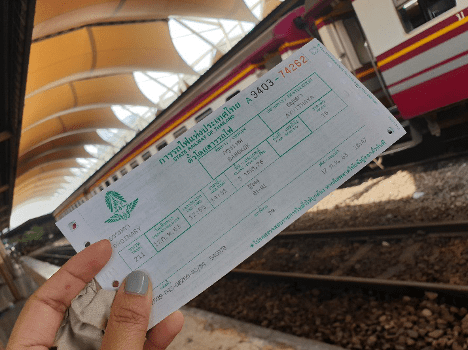
Traveling by train has many price levels according to the class and speed of the train (Special Express, Express, Rapid). First and second class can be booked online. The third-class ticket (Ordinary Train) will be available only on the date and paid by cash only.
The price is also varied if air conditioning and/or a sleeping bed are provided in first-class and second-class trains. The train speed is not a significant difference for Ayutthaya as the estimated duration is around 1.30-1.45 hrs.
Fare
Daily Train Timetable Bangkok – Ayutthaya
| Train Number | Type | Bangkok Departure | Ayutthaya Arrival | ||
| 1 | 303 | Ordinary | 4:20 | 5:48 | |
| 2 | 339 | Ordinary | 5:20 | 6:44 | |
| 3 | 21 | Special Express | 5:45 | 6:58 | |
| 4 | 135 | Rapid | 6:40 | 8:25 | |
| 5 | 111 | Rapid | 7:00 | 8:37 | |
| 6 | 75 | Express | 8:20 | 9:41 | |
| 7 | 7 | Special Express | 8:30 | 9:47 | |
| 8 | 201 | Ordinary | 9:25 | 11:27 | |
| 9 | 71 | Express | 10:05 | 11:24 | |
| 10 | 3 | Special Express | 10:50 | 12:15 | |
| 11 | 209 | Ordinary | 11:20 | 13:04 | |
| 12 | 233 | Ordinary | 11:40 | 13:06 | |
| 13 | 211 | Ordinary | 12:55 | 14:31 | |
| 14 | 109 | Rapid | 13:45 | 15:17 | |
| 15 | 207 | Ordinary | 14:05 | 15:57 | |
| 16 | 145 | Rapid | 15:20 | 16:56 | |
| 17 | 301 | Ordinary | 16:30 | 18:32 | |
| 18 | 341 | Ordinary | 17:00 | 18:57 | |
| 19 | 317 | Ordinary | 17:25 | 19:12 | |
| 20 | 9 | 18:10 | 19:44 | ||
| 21 | 313 | Ordinary | 18:20 | 20:18 | |
| 22 | 77 | Express | 18:35 | 20:03 | |
| 23 | 139 | Rapid | 18:55 | 20:25 | |
| 24 | 13 | Special Express | 19:35 | 21:06 | |
| 25 | 25 | 20:00 | 21:40 | ||
| 26 | 107 | Rapid | 20:10 | 21:43 | |
| 27 | 23 | 20:30 | 21:52 | ||
| 28 | 133 | Rapid | 20:45 | 22:17 | |
| 29 | 105 | Rapid | 21:00 | 22:22 | |
| 30 | 67 | Express | 21:30 | 22:50 | |
| 31 | 51 | Express | 22:00 | 23:35 | |
| 32 | 141 | Rapid | 22:45 | 0:16 |
Train Station in Ayutthaya
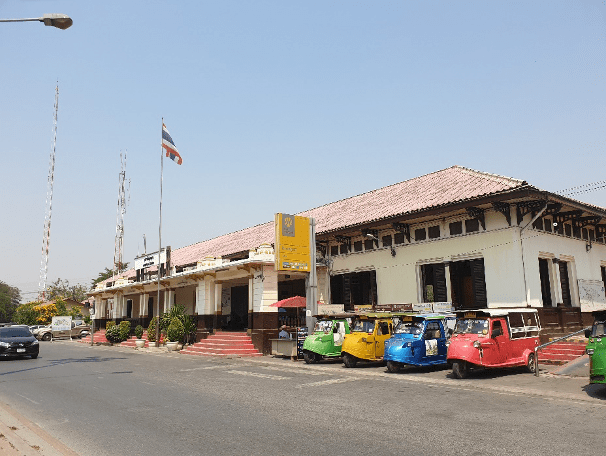
Ayutthaya Train Station is located on the other side of the historical park around 10 minutes away from the center. To get here, we suggest a tuk tuk taxi or Grab if you have luggage.
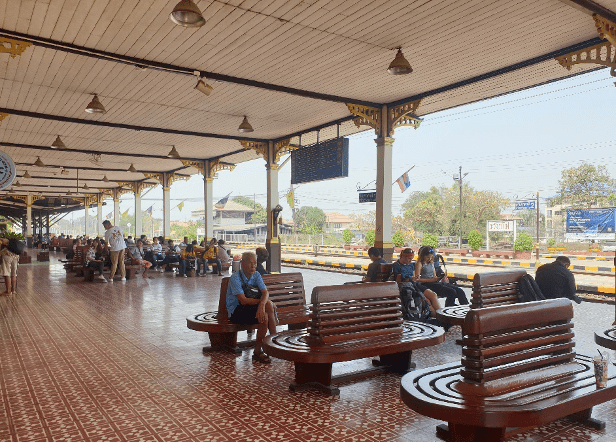
Trains depart from Ayutthaya to Bangkok daily. Ayutthaya Train Station is open 24 hrs. The first train starts from 2.00 am until 21.00pm. In the station, there is free Wi-Fi, an ATM machine, coffee shop, public telephone, toilets, and the 7-11 convenience store is also nearby.
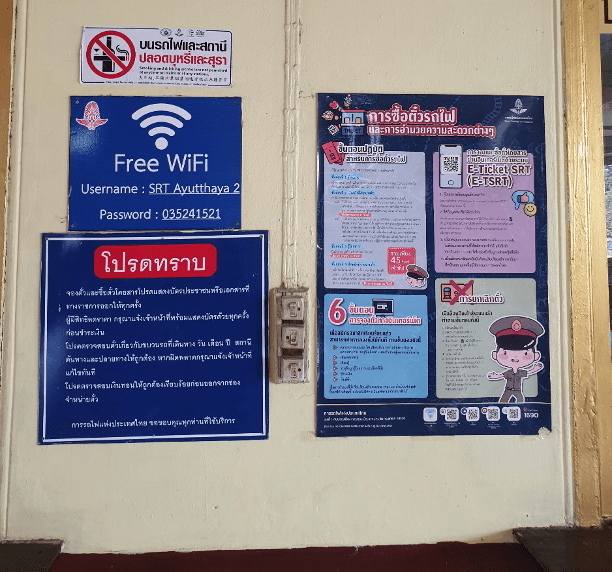
Inside the station there is no air conditioning but it does provide many seats to wait in a large area.
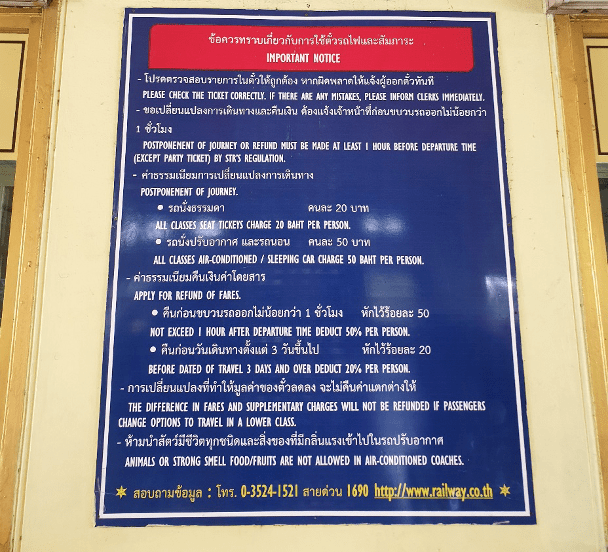
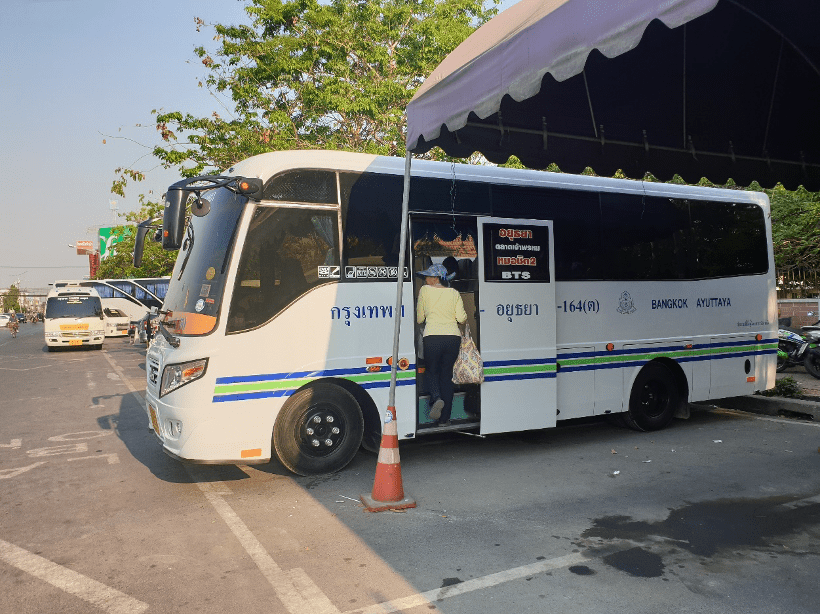
Minibuses depart daily from Mo Chit Bus Terminal in Bangkok’s north. The bus will bring you to downtown Ayutthaya at the market Talad Chaoprom, which is very close to Ayutthaya Historical Park. The bus will depart every 20-30 mins.
Operating hours
Bangkok – Ayutthaya: 06.00-20.00
Ayutthaya – Bangkok: 04.00-18.00
Fare: 70 THB
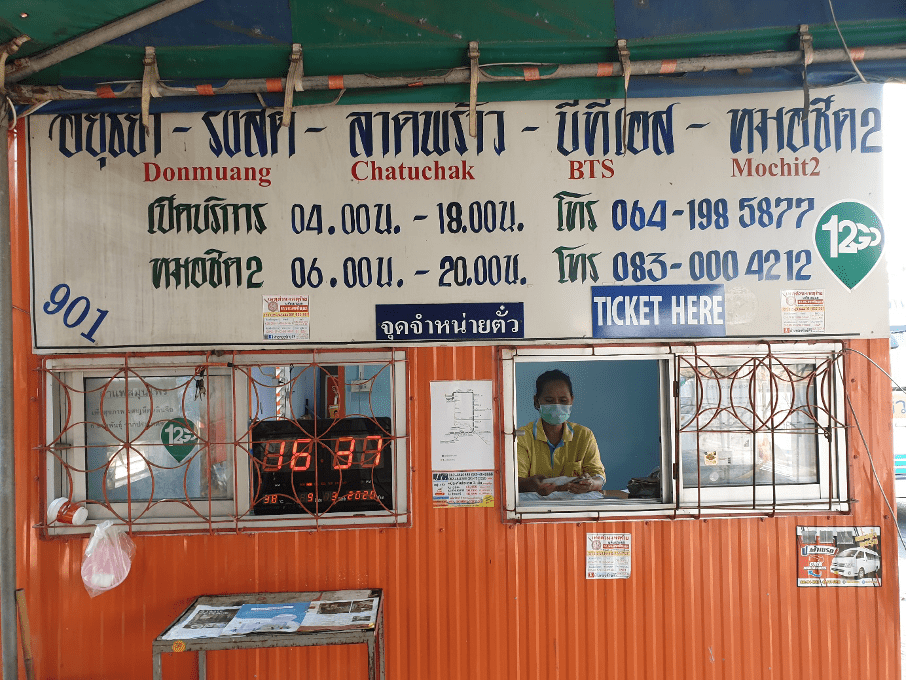
If you come from downtown Bangkok downtown, the most convenient way to get to Mo Chit Bus Terminal and avoid traffic is by BTS Skytrain or MRT underground train.
Get off at Mo Chit Station and take a taxi or motorbike taxi from station to Mo Chit Bus Terminal.
Get off at Kamphaeng Phet MRT station and take a taxi or motorbike taxi from the station to Mo Chit Bus Terminal.
This is the most convenient option and provides pick up from your accommodation and is also the fastest way to go to Ayutthaya. The price will vary by the pickup location and the destination. Estimated fare one way to and from Bangkok- Ayutthaya is 1,100-1,500 THB.
Maximum capacity per car is around 3-4 passengers. So it would be a good option if you have company.
Roads in Ayutthaya are connected and there is less traffic. Each historical monument is also not far from another, so even without a private car, we still can explore Ayutthaya in many ways:
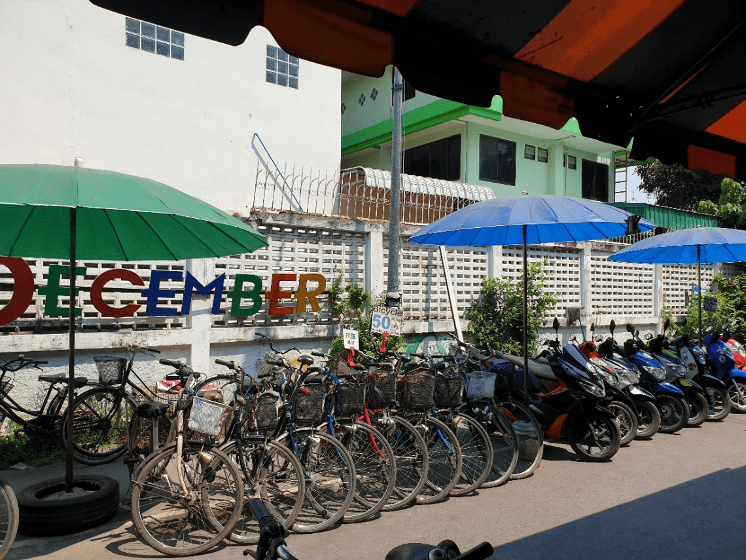
Many places provide rental services, especially in the area near the train station or bus station and they don’ require an international driving license.
To book, the shop will need your original passport as a guarantee, or you can use 3,000 THB in case + ID card as a guarantee.
Fare for day used (return before 18.00pm)
Bicycle: 50 THB/day
Motorcycle: 200 THB/day
Fare for overnight (24 hrs)
Bicycle: 80 THB/day
Motorcycle: 300 THB/day

This is the fastest way to explore the city with a local driver. Most motorcycle taxis are located in crowded areas around the city and easy to spot by their orange uniform. They charge the fare from point to point. Price depends on the distance. You also can hire them for tour which is around 200-300 THB/ hour.
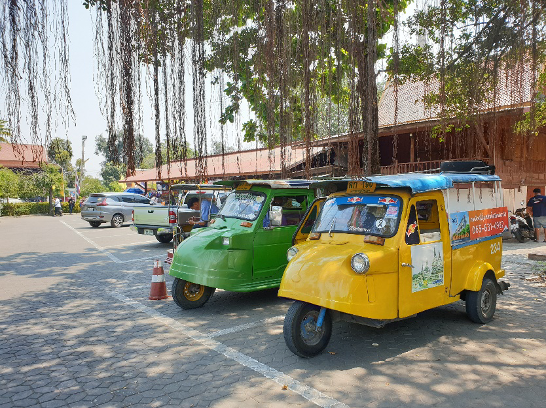
Groups of tuk tuk drivers are often together in certain locations, for example, in front of popular tourist attractions. Each tuk tuk location has a different charging fare depending on their start point. There is standard price from point to point in the charge.
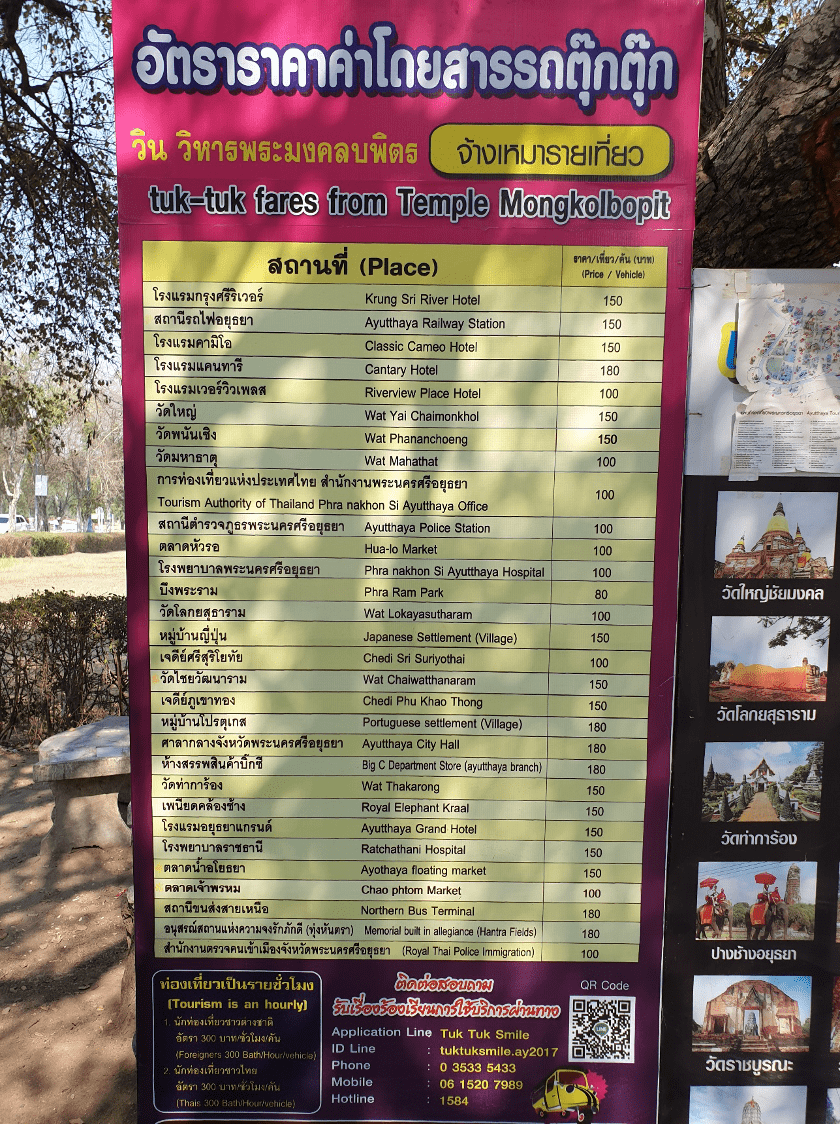
By the way, if you would like to hire one for hours to explore many temples, they charge 300 THB/hour. If you are quoted more than this, then negotiate.
Ayutthaya makes a great day trip from Bangkok. At Expique we offer tours to Ayutthaya so please do check out our tour – An Ayutthaya Adventure.
At Expique our mission is to help people discover the real Bangkok (and beyond) and the local cultures. We do this through a combination of offering our own award winning tours and through producing informative content.
Our range of experiences in Bangkok including our award winning Bangkok Night Lights Tuk Tuk Tour and our foodie extravaganza Evening Food & Tuk Tuk Adventure.
Subscribe to our newsletter to receive monthly news and tips about exploring Bangkok.